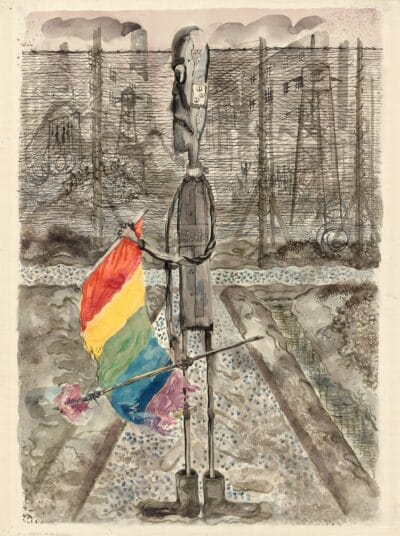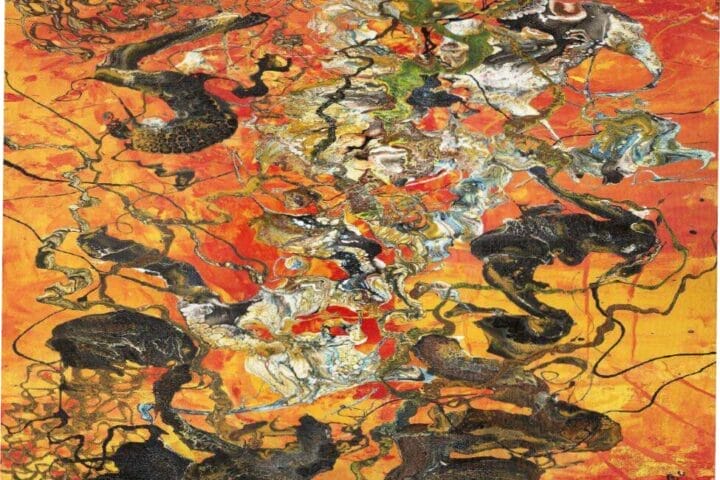NEW YORK—A major exhibition by internationally renowned German-born artist George Grosz will be on view at The Heckscher Museum of Art in Huntington, New York, from May 11 through September 1, 2024. George Grosz: The Stick Men presents a post-apocalyptic world envisioned by the artist after World War II. The exhibition is accompanied by a fully illustrated catalogue.

Featuring 33 watercolors, oils, and drawings, the exhibition is the first dedicated to the Stick Men series since it debuted in New York City at the Associated American Artists galleries in 1948. Seventy-five years later, Grosz’s warning against fascism and global conflict is as relevant as ever.
George Grosz (1893–1959) created the Stick Men series in Huntington, New York, where he lived from 1947 until shortly before his death. Grosz remained invested in political art following his immigration to the United States in 1933. In the Stick Men series, he reaffirms how art reflects and impacts society.
George Grosz: The Stick Men was organized by Das kleine Grosz Museum in Berlin, which is dedicated to the career of this important artist. Featuring works from The Heckscher Museum and European public and private collections, the Berlin exhibition was extended due to its popularity.
At The Heckscher Museum, an expanded exhibition will include additional works from its own collection, including Grosz’s masterpiece Eclipse of the Sun (1926). It will also feature loans from The Whitney Museum of American Art, Addison Gallery of American Art, Frances Lehman Loeb Art Center at Vassar College, and Harvard Art Museums, among others.
Grosz’s images depict hollow figures which offer a searing indictment of humanity following World War II, the Holocaust, and the dropping of atomic bombs on Hiroshima and Nagasaki. Stick Men is the term that defines Grosz’s drawing of a man made only of bones. He used the figure to represent the universal victim of war, “sometimes camp prisoner, forced laborer, sufferer from starvation and war refugee,” notes Pay Matthis Karstens and Juerg Judin in the exhibition catalogue.
It was in response to the harrowing atrocities of World War II that Grosz created the Stick Men, his last major series of works. He lived in the United States beginning in 1933, became an American citizen in 1938, and moved to Huntington, NY, in 1947. The Stick Men series represent dehumanized and starved beings wandering aimlessly through a polluted, post-apocalyptic world. In search of food and shelter, these victims of adverse circumstances in turn become perpetrators themselves.
Writings of the period portrayed Grosz as living a suburban and apolitical life in America, in contrast to his earlier fierce political art created in Germany. The opposite is true: the Stick Men series culminates his lifelong political and artistic struggles. The series strengthens his artistic-political legacy, which could not be more topical considering current world crises.
Heather Arnet, Executive Director and CEO, The Heckscher Museum, observes: “In Stick Men, Grosz presents the viewer with the realities of the two successive world wars and the indelible impacts that would be felt by the people long after flags were waved and victors announced.”
George Grosz: The Stick Men was co-curated by Karli Wurzelbacher, Ph.D., Chief Curator, The Heckscher Museum of Art, and Pay Matthis Karstens, Ph.D., Curator, and Alice Delage, Ph.D., Co-Curator, Das kleine Grosz Museum, Berlin, Germany.
Exhibition Catalogue
Accompanying the George Grosz: The Stick Men exhibition is an illustrated 152-page hardcover book in German and English. The publication includes essays by Pay Matthis Karstens and Juerg Judin at Das kleine Grosz Museum (“George Grosz’s Stick Men”), and Karli Wurzelbacher, Chief Curator at The Heckscher Museum of Art (“Demons in the Suburbs: George Grosz on Long Island”). The book can be ordered at Heckscher.org/GroszCatalog.
George Grosz: The Stick Men is supported by Pien and Hans Bosch, and Andrea B. and Peter D. Klein.









